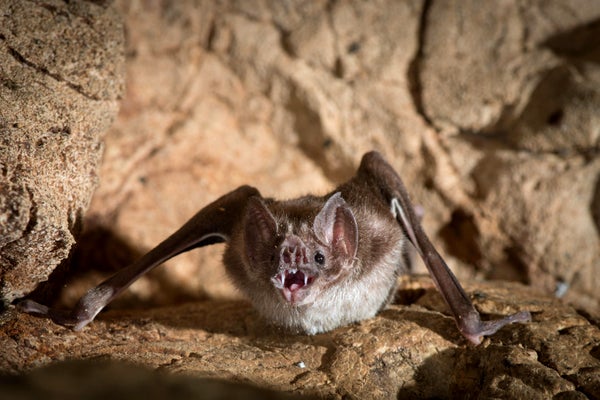Vampire bats—and their legendary taste for blood—are the stuff of nightmares. “Essentially they are living Draculas,” says Michael Hiller, a genomicist at the LOEWE Center for Translational Biodiversity Genomics in Frankfurt, Germany. These tiny bats, which reside in forests and caves throughout Central and South America and often prey on livestock, are the only mammals that feed exclusively on blood. New research on the bats’ genome by Hiller and his colleagues helps explain how they are able to live on such a nutrient-poor diet.
Though vampire movies treat blood like an elixir, the watery fluid is nearly devoid of carbohydrates and fats, and it has few calories. Because of these deficiencies, vampire bats have lower insulin levels than other mammals and must drink up to 1.4 times their body weight in blood at each meal to get enough nutrients. Guzzling this much blood is dangerous, though, because it is laced with high concentrations of iron, which can wreak havoc on the digestive tract and liver. Despite weighing a little more than a single AA battery, vampire bats consume an estimated 800 times more iron in their diet than the average human.
Scientists have long been puzzled over how vampire bats survive on such a paltry diet. In an attempt to answer this question, Hiller and his colleagues recently plunged into the genetics of these legendary bloodsuckers using state-of-the-art sequencing techniques. They pieced together and analyzed the genome of the common vampire bat (Desmodus rotundus) and compared it with the genomes of 26 other bat species, hoping to pinpoint the specific genes that help vampire bats stomach blood.
On supporting science journalism
If you're enjoying this article, consider supporting our award-winning journalism by subscribing. By purchasing a subscription you are helping to ensure the future of impactful stories about the discoveries and ideas shaping our world today.
Their findings, published on Friday in the journal Science Advances, illustrate that when it comes to the genetics of drinking blood, less is more. Instead of developing extra genes to help process blood, the researchers discovered, vampire bats have actually lost 13 key genes—10 of which represented previously unknown losses—over the course of their evolution, compared with other species. “Typically, when we hear about mutations destroying genes, we think that’s a bad idea,” Hiller says. “But in this study, we found that losing certain genes can be beneficial for adapting to this very special diet.”
The ramifications of these deleted genes are evident everywhere, from the bats’ brain to their intestines. Some deletions were responsible for reducing insulin secretion, which is less important, thanks to the animals’ low-sugar diet. Others reduced the amounts of sweet and bitter taste receptors, making the bats less sensitive to the noxious taste of the blood they lap up.
One of the deletions was related to the sculpting ofthe vampire bats’ strange stomach. It is shaped like a floppy wind sock and specialized for a single task, says Melissa Ingala, a bat biologist at Fairleigh Dickinson University, who was not involved with the study. “That shape has evolved to fill up like a water balloon and get as much water out of the blood as possible so that all they’re left to digest is the actual solid cellular component of the blood,” she says. This means that vampire bats must begin urinating immediately after feeding to expel all the excess water sloshing inside their stomach and weighing them down.
Another lost gene, called REP15, was once responsible for keeping iron in the bats’ bloodstream and out of their intestines. Without this stopgap in place, iron is able to seep into the cells along the intestinal wall. But the researchers hypothesize that this seeping is actually good for the bats. The intestinal cells are short-lived and easily replaceable, meaning the bats can shed them through their digestive systems and expel them in iron-rich droppings instead of having the extra iron continue to course through their bloodstream.
The vampire bat brain may have also benefitted from a fortuitous gene loss. CYP39A1 is a gene primarily responsible for degrading a by-product of cholesterol digestion. Without it, the levels of that so-called metabolite in the bats’ brain skyrocket. Past research has determined that higher levels of the metabolite was responsible for increasing memory, learning and sociability in rodents. That may help explain why vampire bats appear to be smarter and more social than their bat brethren.
This potential cognitive boost and increased sociability helps the bats survive their blood-drinking lifestyle. Because of their nutrient-poor diet, vampire bats have meager stores of energy, making them particularly vulnerable to starvation. Going multiple nights without slurping up blood is often fatal. So vampire bats will readily help out a hungry roost mate by regurgitating blood into their companion’s mouth. Remarkably, the bats often return the favor, providing blood to others who have helped them out in the past. This makes it crucial to have a strong memory. “Vampire bats develop long-term friendships with each other built on this mutual food sharing,” Ingala says. In the compassionate world of vampire bats, blood is a dish best shared with the ones you care about.
